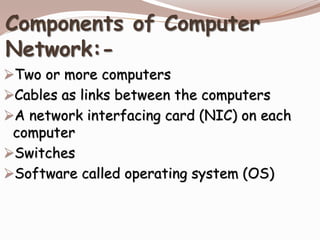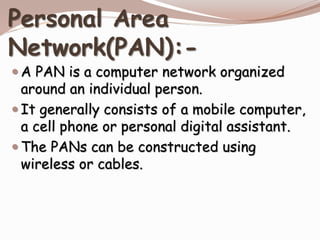Computer network
- 2. Definition & Applications:- ïDEFINITION: A computer network is defined as the interconnection of two or more computers. It is done to enable the computers to communicate and share available resources. ïAPPLICATIONS: i. Sharing of resources such as printers ii. Sharing of expensive softwareâs and database iii. Communication from one computer to another computer iv. Exchange of data and information among users via network v. Sharing of information over geographically wide areas
- 3. Components of Computer Network:- ïTwo or more computers ïCables as links between the computers ïA network interfacing card (NIC) on each computer ïSwitches ïSoftware called operating system (OS)
- 4. Networking Transmission Media:- ïą We can group the communication media in two categories: 1) Guided Media: It include cables. 2) Unguided Media: It include waves through air, water or vacuum.
- 5. Guided Media:- ïTwisted Pair ïCoaxial Cable ïOptical Fibre
- 6. Unguided Media:- o Long distance Wireless media: a) Microwave b) Radio Wave c) Satellite o Short distance Wireless media: a) Infrared b) Laser c) Bluetooth d)Wi-Fi e) WiMax
- 7. Network Benefits:- ïąThe network provided to the users can be divided into two categories: i. Sharing ii. Connectivity
- 8. Sharing Resources:- ïąTypes of resources are: 1. Hardware: A network allows users to share many hardware devices such as printers, modems, fax machines, CD ROM, players, etc. 2. Software: Sharing software resources reduces the cost of software installation, saves space on hard disk.
- 9. Other Benefits of Computer Network:- oIncreased speed oReduced cost oCentralized software managements oElectronic mail oFlexible access
- 10. Disadvantages of Networks:- ï High cost of installation ï Requires time for administration ï Failure of server ï Cable faults
- 11. Classification of Area by their Geography:- NETWORK PAN LAN WAN MAN CAN
- 12. Local Area Network(LAN):- ï§ LAN is a network which is designed to operate over a small physical area such as an office, factory or a group of buildings. ï§ These are easy to design and troubleshoot. ï§ It is usually a privately owned network. ï§ In LAN all machines are connected to a single cable.
- 13. Wide Area Network(WAN):- ï§ WAN is a group of computers that are separated by large distances and tied together. ï§ It is cheaper and more efficient to use the phones network for the limbs. ï§ Most WAN networks are used to transfer large blocks of data between its users.
- 14. Personal Area Network(PAN):- ï A PAN is a computer network organized around an individual person. ï It generally consists of a mobile computer, a cell phone or personal digital assistant. ï The PANs can be constructed using wireless or cables.
- 15. Campus Area Network(CAN):- ï The CAN is made up of an interconnection of LAN with limited geographical area. ï Network equipments such as switches, routers and the transmission media i.e. optical fibre etc are almost entirely owned by the campus owner.
- 16. Metropolitan Area Network(MAN):- ï It is in between LAN & WAN technology that covers the entire city. ï It uses similar technology as LAN. ï It can be a single network such as cable TV network, or a measure of connecting a number of LANs or a large network so that resources can be shared LAN to LAN as well as device to device.
- 18. Internet:- Internet is a computer based worldwide information network. The Internet is composed of a large number of smaller interconnected networks. Internet is a decentralised system. It has made it possible for all over the world to effectively and inexpensively communicate with each other.
- 19. SUMMARY:- ïķDefinition & Application ïķComponents of Computer Network ïķNetwork Transmission Media ïķNetwork Benefits ïķDisadvantages of computer network ïķClassification by their geographical area ïķInternet
- 20. Made By :- Ketan Garg , Harmanjeet Singh Aasht & Jaspreet Singh Gill





















